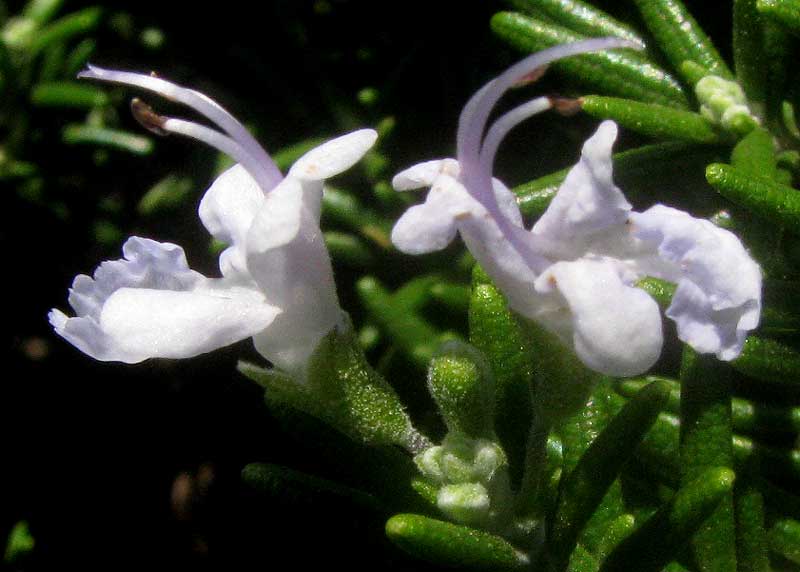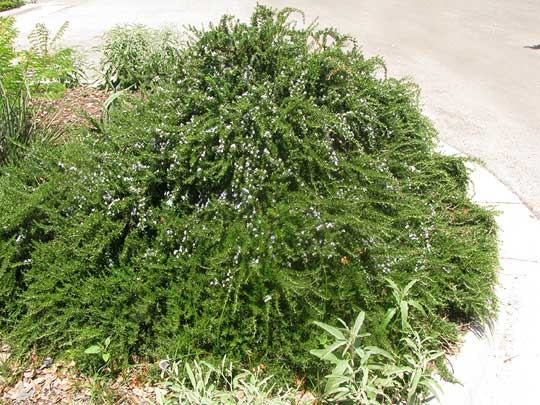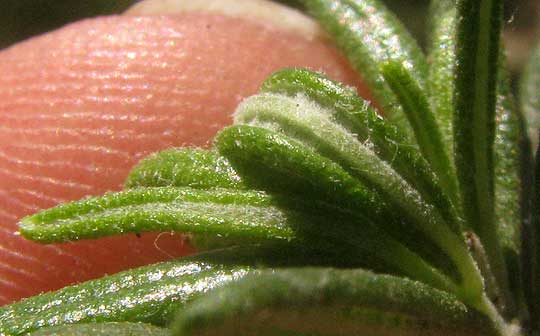Excerpts from Jim Conrad's
Naturalist Newsletter

from the June 15, 2014 Newsletter issued from the Frio Canyon Nature Education Center in the valley of the Dry Frio River in northern Uvalde County, southwestern Texas, on the southern border of the Edwards Plateau; elevation ~1750m (~5750 ft); N29.62°, W99.86°; USA
PROSTRATE ROSEMARY
In a traffic island in the parking lot of Uvalde's fine public library a dense, woody shrub formed a waist-high mound with branches cascading onto the sidewalk, and the bush was full of small, pale flowers, creating an effect I couldn't remember seeing before. The whole thing is shown below:

Up close, the flowers showed themselves to be typical blossoms of the Mint Family, the Lamiaceae, the main field marks being their strong bilateral symmetry (only one way to cut them down the middle so that mirror images are seen on both sides of the cut), having only two stamens (in other families with similar flowers 5 is more typical), and, down in the bottom of the flowers' throats the ovaries were deeply four-lobed, forming four little green "nutlets" looking tiny green eggs with the slender style arising between them. Two flowers are shown at the top of this page.
The flowers bespoke the Mint Family, but the shrub's leaves were distinctive enough to identify exactly what kind of mint we had, for they were small and slender, leathery, and their margins curled beneath the blades in a way not often seen. A picture with a leaf in the middle showing its rolled under margins is shown below:

This was a Rosemary plant ROSMARINUS OFFICINALIS, despite Rosemary normally being thought of as a garden herb that stands quite erect, not at all producing long, trailing branches like this plant. But with such flowers and leaves, and its strong Rosemary odor, it couldn't have been anything else. Clearly it was a cultivar with genes so thoroughly scrambled by generations of horticulturalists that almost anything might result. Our plant looks very much like the cultivar 'Prostratus."
Rosemary's Wikipedia page currently lists 21 frequently selling cultivars of Rosmarinus officinalis, so a gardener could create quite an exhibition just by growing different kinds of Rosemary.
Rosemary is a woody shrub originally from the Mediterranean region. The name "Rosemary" derives from the Latin "ros," for dew, and "marinus," for sea, so the Rosemary herb is "Dew of the Sea."
In my own life, Rosemary is especially welcome during the cooler months when a few Rosemary leaves steeped in hot water make a fragrant, wholesome-smelling tea that somehow is soothing and at least feels as if it's doing good things to my innards.